
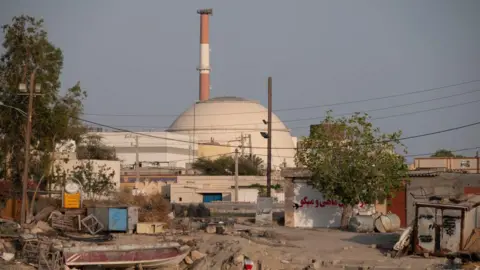 NurPhoto via Getty Images
NurPhoto via Getty Images
Iran insists its nuclear programme is entirely peaceful and that it enriches uranium to produce fuel for power plants like Bushehr
Israel has struck dozens of targets across Iran, damaging the uranium enrichment plant at Natanz and assassinating top military commanders and nuclear scientists in Tehran.
After the first wave of attacks on Thursday night, the Iranian foreign minister condemned what he called Israel's "reckless" attacks on his country's "peaceful nuclear facilities". Iran has since launched retaliatory air strikes on Israel.
Abbas Araghchi said Natanz was operated under the monitoring of the global nuclear watchdog, the International Atomic Energy Agency (IAEA), and that the strikes on the facility risked a "radiological disaster".
However, Prime Minister Benjamin Netanyahu declared that the operation was necessary to "roll back the Iranian threat to Israel's very survival".
He said Israel had acted because "if not stopped, Iran could produce a nuclear weapon in a very short time".
"It could be a year. It could be within a few months," he warned.
Is there evidence Iran was working on a nuclear bomb?
The Israeli military said it had accumulated intelligence showing that "concrete progress" had been made "in the Iranian regime's efforts to produce weapons components adapted for a nuclear bomb", including a uranium metal core and a neutron source initiator for triggering the nuclear explosion.
Kelsey Davenport, director for non-proliferation policy at the US-based Arms Control Association, said Israel's prime minister "did not present any clear or compelling evidence that Iran was on the brink of weaponizing".
"Iran has been at a near-zero breakout for months," she told the BBC, referring to the time it would take Iran to acquire enough fissile material for one bomb if it chose to do so.
"Similarly, the assessment that Iran could develop a crude nuclear weapon within a few months is not new."
She said some of Iran's nuclear activities would be applicable to developing a bomb, but US intelligence agencies had assessed that Iran was not engaged in key weaponization work.
This March, Director of National Intelligence Tulsi Gabbard told Congress that Iran's stockpile of enriched uranium was "at its highest levels" and "unprecedented for a state without nuclear weapons".
But she also said the US intelligence community "continues to assess that Iran is not building a nuclear weapon and Supreme Leader [Ayatollah Ali] Khamenei has not authorised the nuclear weapons programme that he suspended in 2003".
"If Netanyahu was purely motivated by Iran's proliferation risk, Israel would likely have shared that intelligence with the United States and the initial attack would likely have targeted all of Iran's key nuclear facilities," Ms Davenport added.
Last week, the IAEA said in its latest quarterly report that Iran had amassed enough uranium enriched up to 60% purity - a short, technical step away from weapons grade, or 90% - to potentially make nine nuclear bombs. That was "a matter of serious concern", given the proliferation risks, it added.
The agency also said it could not provide assurance that the Iranian nuclear programme was exclusively peaceful because Iran was not complying with its investigation into man-made uranium particles discovered by inspectors at three undeclared nuclear sites.

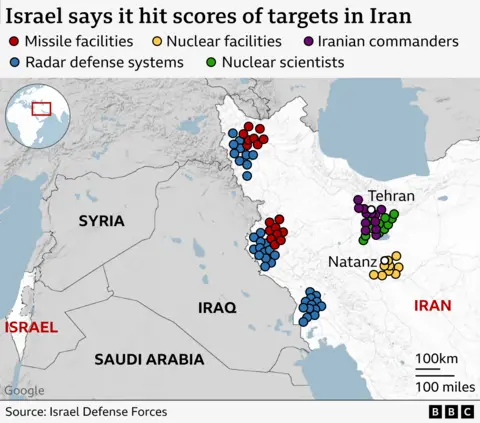
What do we know about Iran's nuclear programme?
Iran has always said that its nuclear programme is entirely peaceful and that it has never sought to develop a nuclear weapon.
However, a decade-long investigation by the IAEA found evidence that Iran conducted "a range of activities relevant to the development of a nuclear explosive device" from the late 1980s until 2003, when projects under what was known as "Project Amad" were halted.
Iran continued with some activities until 2009 - when Western powers revealed the construction of the Fordo underground enrichment facility - but after that there were "no credible indications" of weapons development, the agency concluded.
In 2015, Iran agreed a deal with six world powers under which it accepted restrictions on its nuclear activities and allowed rigorous monitoring by the IAEA's inspectors in return for relief from crippling sanctions.
Key limits covered its production of enriched uranium, which is used to make reactor fuel but also nuclear weapons.
But US President Donald Trump abandoned the deal during his first term in 2018, saying it did too little to stop a pathway to a bomb, and reinstated US sanctions.
Iran retaliated by increasingly breaching the restrictions - particularly those relating to enrichment.
Under the nuclear deal, no enrichment was permitted at Fordo for 15 years. However, in 2021 Iran resumed enriching uranium to 20% purity in 2021.
On Thursday, the IAEA's 35-nation board of governors formally declared Iran in breach of its non-proliferation obligations for the first time in 20 years.
Iran said it would respond to the resolution by setting up a new uranium enrichment facility at a "secure location" and by replacing first-generation centrifuges used to enrich uranium with more advanced, sixth-generation machines at the Fordo enrichment plant.

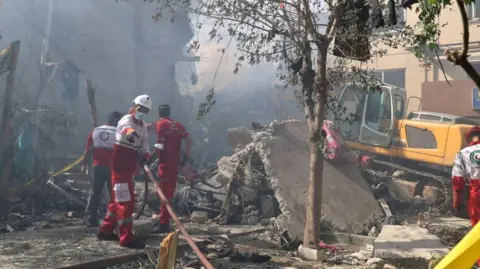 Reuters
Reuters
Israeli strikes in Tehran on Thursday night targeted nuclear scientists and military commanders
What damage has Israel done to Iran's nuclear infrastructure?
The Israeli military said on Friday that its first round of air strikes damaged the underground centrifuge hall at Natanz, as well as critical infrastructure that enabled the site to operate.
The IAEA's director general, Rafael Grossi, told the UN Security Council that the above-ground pilot fuel enrichment plant (PFEP) and electricity infrastructure at Natanz was destroyed. There was no indication of a physical attack on the underground hall, but that the loss of power may have damaged the centrifuges there, he added.
The US-based Institute for Science and International Security said the destruction of the PFEP was significant because the facility had been used to produced 60%-enriched uranium and also to develop advanced centrifuges.
Ms Davenport also said the strikes on Natanz would increase Iran's "breakout time", but that it was too soon to assess the full impact.
"We will not have a clear picture of how quickly Iran could resume operations there or if Iran was able to divert uranium until the IAEA can access the site," she explained.

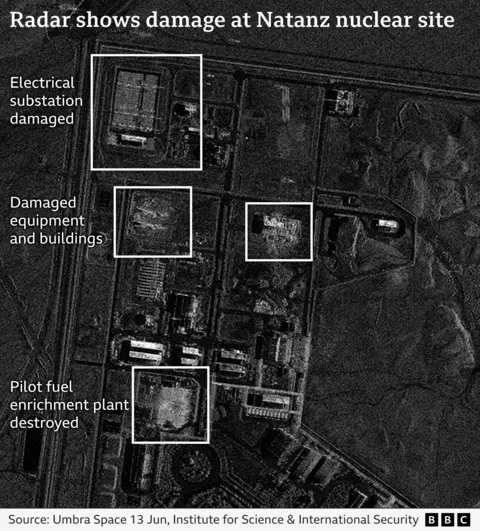
Later on Friday, Iran informed the IAEA that Israel had attacked the Fordo enrichment plant and the Isfahan Nuclear Technology Centre.
The Israeli military said a strike in Isfahan had "dismantled a facility for producing metallic uranium, infrastructure for reconverting enriched uranium, laboratories, and additional infrastructure".
"So long as Fordo remains operational, Iran still poses a near-term proliferation risk. Tehran has the option to ratchet up enrichment to weapons grade levels at the site or divert uranium to an undeclared location," Ms Davenport said.
Israel's prime minister also said the operation would continue for "as many days as it takes to remove this threat".
But that is an unrealistic goal, according to Ms Davenport.
"Strikes can destroy facilities and target scientists but cannot erase Iran's nuclear knowledge. Iran can rebuild, and more quickly now than in the past due to its advances in uranium enrichment," she said.

 Reuters
Reuters
Iran responded to the Israeli strikes by launching ballistic missiles towards Tel Aviv and other cities


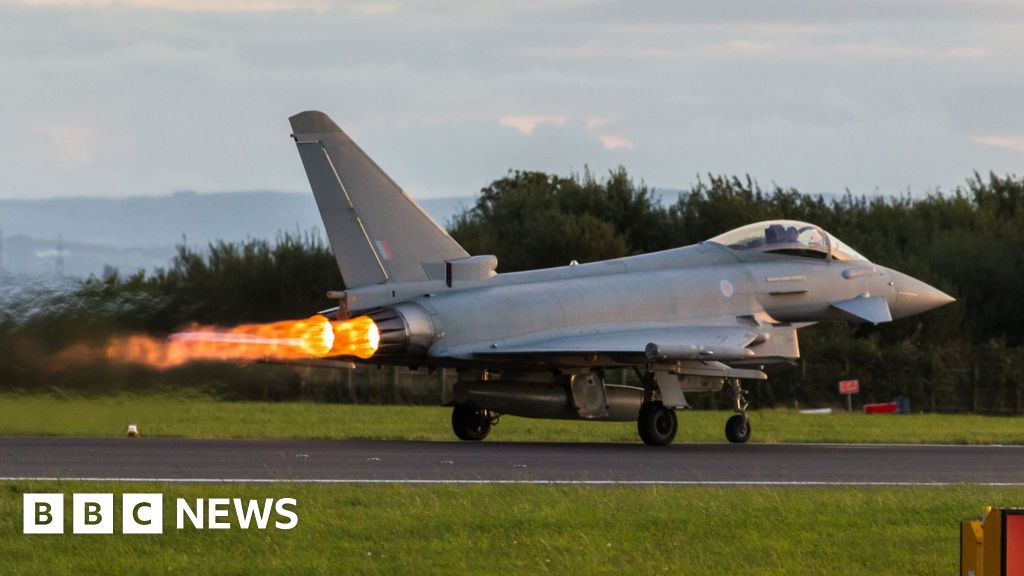






 English (US) ·
English (US) ·